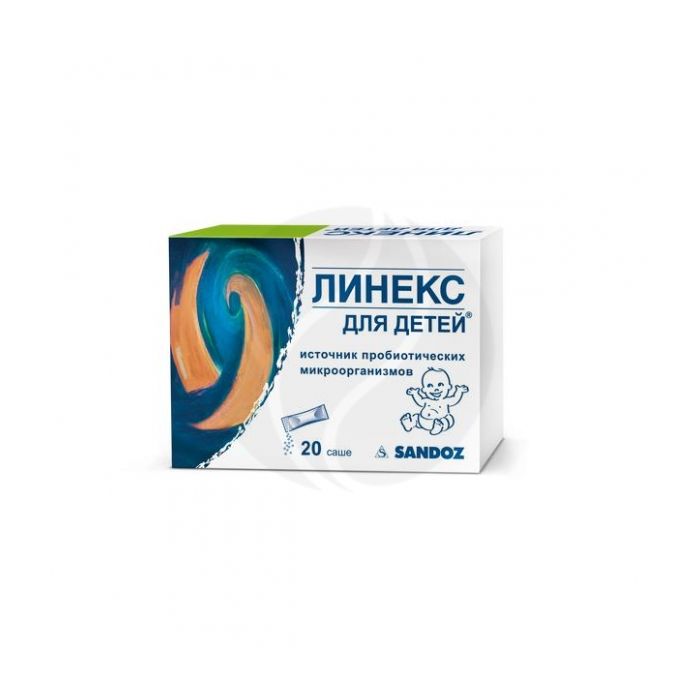Linex for children sachet dietary supplement, No. 20
Expiration Date: 11/2025
Russian Pharmacy name:
Линекс для детей саше БАД, №20
Bifidobacterium Bifidobacterium animalis subsp. lactis (BB-12) in LINEX FOR CHILDRENЃ contribute to:
- establishing and maintaining the balance of the composition and functional state of the intestinal microflora, including in children of the first year of life with such digestive disorders as colic, gas formation, stool disorders (constipation, diarrhea) and other digestive disorders;
- maintaining the balance of the composition and functional state of the intestinal microflora when taking antibiotics and after the end of the course of antibiotic treatment;
- reducing the risk of diarrhea caused by viral or bacterial infections of the gastrointestinal tract (including rotavirus infection);
-support in the formation and functioning of the immune system;
- prevention of atopic dermatitis in children.
Factors that have a negative impact on the formation of the intestinal microflora of the newborn:
Children at risk of imbalance in the intestinal microflora:
-Cesarean section, premature birth;
- Unfavorable course of the neonatal period;
-Late attachment to the breast;
-Long stay in a maternity hospital or hospital;
-Early artificial feeding;
-Physiological immaturity of the intestinal motor function.
Unfavorable moments in the child's life (the risk of imbalance in the intestinal microflora): -
cessation of breastfeeding and / or the introduction of complementary foods;
-teething;
-hospitalization;
-stress (for example, separation from the mother when she goes to work);
- weaning from the breast, weaning from the pacifier;
-treatment with antibacterial drugs (for example, antibiotics);
- frequent acute respiratory infections;
- intestinal infections;
- unbalanced nutrition;
- functional disorders of intestinal motility;
-decreased immunity;
- violation of biorhythms, long trips, change of residence.
These factors disrupt the natural colonization of the intestine with beneficial bacteria and can cause an imbalance in the microflora (dysbiosis), and therefore children at risk of imbalance in the microflora are more prone to functional disorders of the gastrointestinal tract (GIT), food allergies, and are more susceptible to gastrointestinal infections.
Children from birth to 7 years old - 1 sachet 1 time per day with meals; children from 7 to 12 years old, 2 sachets per day with meals.
Open the bag and mix the contents with milk, juice, or another type of baby food.
Do not mix the contents of the sachet with hot drinks - the product temperature should not exceed 35 ? C.
When administered simultaneously with antibiotics, take no earlier than 3 hours after using antibiotics. The recommended duration of admission is 30 days. If necessary, the reception can be repeated after 1 month.
For 1 sachet sachet: filler maltodextrin 1400 mg, lyophilized powder of bifidobacteria 100.0 mg.
The number of probiotic microorganisms Bifidobacterium animalis subsp. lactis (CHR. HANSEN BB-12Ѓ) (strain DSM No. 15954) - not less than 1.0x109 CFU / g (which corresponds to 1.5x109 CFU / sachet).
Maltodextrin is a product of incomplete hydrolysis of starch and is non-toxic. It is an inert excipient that is neutral for the infant's digestion.
Individual intolerance to the components of dietary supplements.
It is recommended to consult a doctor before use.
Pharmacological action
Recommended as a dietary supplement to food - a source of probiotic microorganisms. The probiotic Linex for childrenЃ contains bifidobacteria Bifidobacterium animalis subsp, important for the child. lactis (BB-12).
Bifidobacteria contribute to the natural formation of normal microflora and intestinal function, as well as create an optimal environment in the intestine for the action of digestive enzymes. In addition, bifidobacteria ensure the proper formation of immunity and help reduce the risk of developing infectious diseases, the possibility of atopic dermatitis and food allergies in young children. In breastfed children, it is bifidobacteria that make up 60-91% of the microflora.

